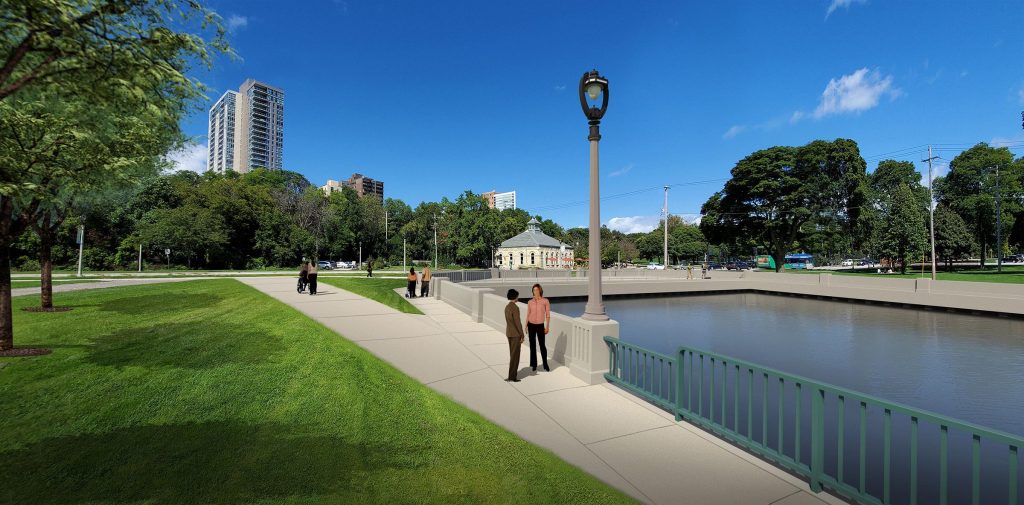Supervisors Stall, Inflate Cost of Sea Wall Project
Cost of McKinley Flushing Channel rises as county board second guesses engineers.
The massive backlog of needed infrastructure maintenance and repairs in the Milwaukee County Parks system means that every supervisor on the board has a list of parks projects they’d like to see in the annual budget each year.
But in a vast parks system like Milwaukee’s, not every infrastructure project is going to be exciting or ripe for a ribbon cutting. And some of these boring projects will be expensive. One such infrastructure project is currently being held up by the Milwaukee County Board of Supervisors, as they wait for a hypothetical cheaper, better alternative that engineers might have somehow missed the first time around.
The flushing channel was built in the 19th century by the City of Milwaukee to pump water from the lake to the stagnant Milwaukee River. It was later transferred to the Milwaukee Metropolitan Sewerage District (MMSD), which still has an active pipe that runs to the channel, though pumping has not occurred since the 1990s. The building that currently houses the Colectivo cafe at 1701 N. Lincoln Memorial Dr. is the former pumping station for the channel.
The county’s process for getting an infrastructure project from planning to completion regularly takes several years — especially given the county’s limited resources for maintenance and new construction. And with the turnover on a board that runs for re-election every two years, it’s common for supervisors to consider and vote on projects that were set in motion before they took office.
For instance: County Executive David Crowley included approximately $5.6 million in his 2023 budget proposal to build out the redesigned flushing channel. The project, which is shovel-ready, was hobbled by the board during budget deliberations. Supervisors split the funding in two and directed $2.4 million toward repairs to one section of the Lake Michigan breakwater along South Shore Park. The funding would address immediate needs to stabilize the breakwater, but would not be a long-term fix.
The amendment that broke up the funding asked the parks department to return to the board with a report “evaluating lower cost alternatives” including simply filling in the McKinley Flushing Channel.
The original $300,000 engineering and design report contemplated a number of different design alternatives; each with various tradeoffs in terms of costs and sustainability. Parks came back to the board in January with an estimate for filling in the channel, which was just barely cheaper than the shovel-ready project. It also would need to be redesigned by engineers, and it would also require a number of governmental and regulatory approvals from state agencies like the Department of Natural Resources (DNR), as Jeremy Lucas, director of administration and planning, explained to supervisors.
Sup. Peter Burgelis, who has, since the budget process last year, been the primary advocate for scuttling the project, was displeased with the report from the department when it went before the board’s Committee on Parks and Culture earlier this month. He continued his demand for a lower-cost alternative again when the project went before the board’s Finance Committee. Burgelis, who works as a loan originator for U.S. Bank and admits that he’s “not an expert on sea walls and construction and cost-estimating,” nonetheless asserted that the project recommended by engineers and parks staff is “overbuilt.”
Engineers from Collins Engineers, Inc. considered a number of designs for the project, including some that were cheaper than the final option they recommended to parks. But they landed on their final recommendation, not because it came with the lowest up-front price tag, but because it is “the most cost-effective, lowest maintenance, long-term solution.”
Burgelis told the parks committee, “We certainly want to be good stewards of our limited tax dollars,” and suggested the department could consider using wooden supports for the reconstruction. “Those timber supports have served that flushing channel wall for decades.”
The Army Corps of Engineers, however, appears to disagree with Burgelis. In an email obtained by Urban Milwaukee, Clifton Janssen, a county senior civil engineer, told Lucas that he spoke with Army Corps engineers from the Chicago District and they told him they “do not use this method,” out of concern for the deterioration of the wood. Janssen explained that using timber for projects like this was last popular roughly a century ago. The modern-day engineers already paid by the county to design a new seawall for the channel recommend using steel sheet pile.
A majority of both the board’s parks and finance committees were swayed by Burgelis’ contention that the parks department had not sought the most cost-effective solution for the flushing channel, and both committees voted to hold the items in committee. Supervisors will not be able to reconsider the proposal again until March.
Because the funding was split up, and parks will have to seek funding to complete the project in the 2024 budget, inflation will increase the cost of the project as it already has. When engineering and design finished in 2021 the estimated cost was approximately $3.8 million. By the time construction costs made their way into Crowley’s 2023 budget request, inflation had pushed cost estimates up to the $5.6 million that supervisors ultimately cut in half.
Sup. Shawn Rolland, one of the three supervisors on the Finance Committee who sought to move the project along noted this, saying, “Nothing is getting less expensive. Inflation is what it is.”
Parks is concerned about getting the project bid in time for the 2023 construction season now that the soonest they could begin soliciting a contract would be the beginning of April. By which time, many contractors will have set their schedules for the year.
UPDATE: An earlier version of this article stated the water flowed from the river to the lake. The system was created to run from the lake to the river.
If you think stories like this are important, become a member of Urban Milwaukee and help support real, independent journalism. Plus you get some cool added benefits.
Political Contributions Tracker
Displaying political contributions between people mentioned in this story. Learn more.
MKE County
-
J.D. Vance Plays Up Working Class Roots, Populist Politics in RNC Speech
Jul 17th, 2024 by Graham Kilmer -
Ron Johnson Says Free-Market Principles Could Fix Education
 Jul 17th, 2024 by Graham Kilmer
Jul 17th, 2024 by Graham Kilmer
-
RNC Will Cause Some County Services To Be Moved to Wauwatosa
 Jul 12th, 2024 by Graham Kilmer
Jul 12th, 2024 by Graham Kilmer






















@Urban Milwaukee – Can you please start tagging @Graham’s writing as opinion? A “shovel-ready” project does not necessitate its completion nor does it guarantee that the priorities haven’t changed. I think it’s pretty clear that stabilizing South Shore was more important than rebuilding this channel, yet Graham wants to write another piece about “Loan Originator for US Bank” Sup. Peter Burgelis.
Everything he writes comes across as condescending and biased.
Thanks for an interesting story. However, the flushing channel and pump house were built to pump water from the lake to the river, thereby “flushing” what was then a terribly polluted urban waterway.
Seriously: “second guesses engineers”. I was not at the meeting quoted, but asking an engineer “Why can’t you do it in a way that it’s been done in the past” is a legitimate question. Burgelis is not an engineer, but it’s a pretty good sign IMHO that he’s at least asking if other options were explored rather than rubber stamping everything.
Well, I think it makes sense to go with “the most cost-effective, lowest maintenance, long-term solution” and not simply with the cheapest current solution.
That said, I take Kilmer’s writing as bold and frank. Not condescending, but definitely on point. Love it!
@polaris – “the most cost-effective, lowest maintenance, long-term solution” ignores the greatest variable in the whole equation. The county has budgeted a finite amount of $ for the project. They had to split the available budget due to a higher-priority project. Without an increase in budget, they have to look at the goals of what they were trying to do without the necessary budget. A budget decrease of 42% requires a fundamental reapproach to the previous solution.
Nonetheless, I stand by Kilmer’s writing should be marked and opinion. “Bold and Frank” should be reserved for opinion. Journalism should be characterized by “truthful and unbiased”. Unbiased it definitely is not.